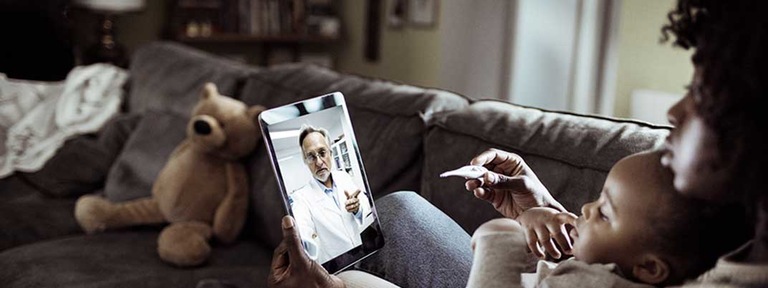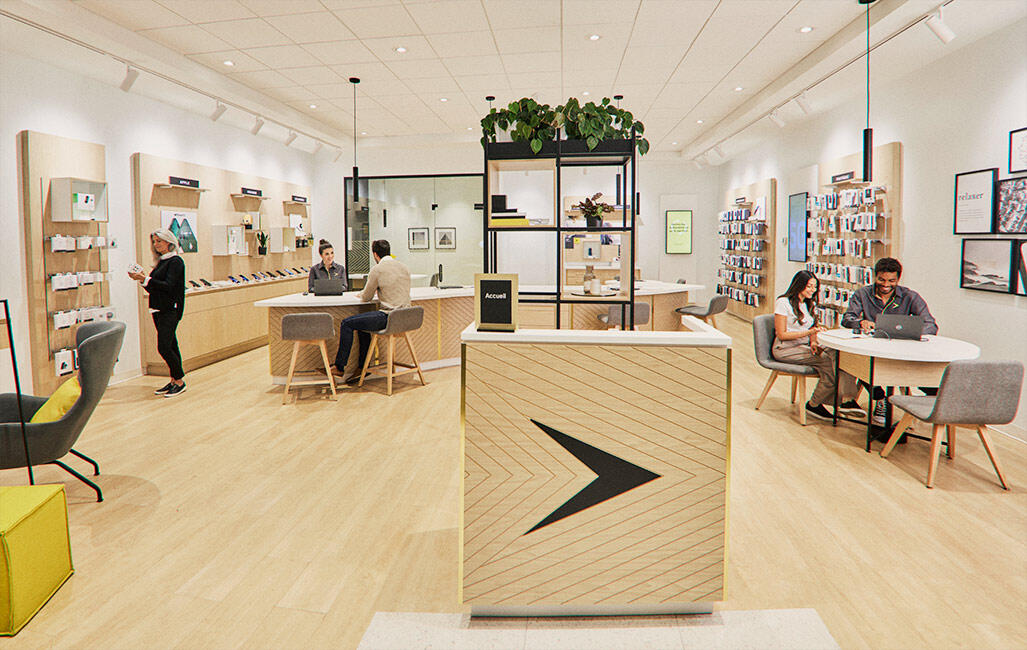
Whether it’s to overcome the labour shortage, enhance a digital transformation that accelerated due to the pandemic, or respond to the needs of an aging population, technology lies at the heart of the health system both now and for the foreseeable future.
Facts
60% of consultations in Canada in April and May 2020 were done virtually.[ln]
80% of those who had a virtual consultation hope the service will continue to be available post-pandemic.[ln]
74% Internet usage rate among the elderly in Québec.[ln]
The growth of remote digital healthcare services
It would be an understatement to say that the pandemic has promoted the adoption of remote digital healthcare services. In Canada, in April and May of 2020, 60 percent of consultations occurred virtually, with bookings being made in some cases just a few weeks in advance, according to consulting firm Deloitte.
And it’s the same story everywhere else. So it’s not surprising that investments in digital health services worldwide increased from $13.56 billion to $26.36 billion between 2019 and 2020, according to research firm Mercom Capital Group. That’s an increase of 103 percent, and the effects are likely to continue to be felt for a few more years to come. Which is great news, since 80 percent of people who had a virtual consultation hope to continue using this service after the pandemic, according to a Deloitte study released in May of 2020.
Québec has played its cards particularly well with regard to remote medical consultations, both in terms of private solutions and those used in hospitals and the public system.
Olive Santé, for example, offers Quebecers a remote consultation service without any need for a private appointment, offered with unlimited accessibility by subscription, all provided through a smartphone or tablet. One sign of its positive reception has been the fact that 95 percent of Olive users give the application a five-star rating following an online consultation with one of their doctors. In the meantime, the platform Reacts is used within the health network to facilitate instant messaging as well as secure document transfer, medical consulting, and remote education.
To offer these medical consulting platforms, healthcare facilities must have a robust Internet network, such as the one provided by fibrenoire’s dedicated fibre optic connection. This type of connection increases the security of the network because it is not shared, a particularly important aspect in the healthcare sector. For increased security, fibrenoire also offers cloud-based security, a next-gen security solution that protects data in the cloud, including security for employees working remotely. Long-distance consultations made from home are therefore just as secure as those hosted at the hospital.
It’s also one of the three essential elements to consider for sustainable remote working : Your level of security should be the same whether you’re at home or at the office.
Dedicated fibre can also be fast (from 10 Mbps to 10 Gbps, making it accessible to both small practices and big institutions), and therefore allows you to connect a larger number of devices simultaneously.
A professional Wi-Fi network should also be installed and accessible to employees. This latter aspect is even more important given that healthcare practitioners increasingly need to access the Internet using their mobile devices to take advantage of the latest innovations. Québec service Pathway MD, for example, is accessible by phone or tablet and provides doctors ministering to the needs of their patients with access to the most recent clinical directives and the latest research on over 700 illnesses.
With over 2,000 articles in medical science being published every day, doctors cannot be expected to know everything. A service like Pathway MD, powered by artificial intelligence and edited by medical experts, allows doctors to provide the best possible care to their patients. But they’ll still need to have a good Internet connection, throughout the entire hospital.
Good to know
Using the Internet of Things for overcoming the labour shortage
The labour shortage being experienced throughout many sectors of activity (as of this writing, there are 279,000 vacant jobs in Québec according to Statistics Canada) is particularly an issue in the healthcare system, where the reduced workforce that has had to confront the pandemic for almost two years has been stretched to the limit. The result: there’s not only a lack of workers, but thousands who are often absent for a variety of reasons, but especially due to overwork. According to a tabulation by the Journal de Montréal, close to 9,000 nurses were on vacation or at home due to illness in the fall.
Unfortunately, it’s hard to find new employees. But if you can’t obtain fresh recruits, there are some technologies that can facilitate the work of existing employees.
This is particularly true of the Internet of Things (IoT), which is the name given to the billions of Internet-connected devices worldwide.
Examples in which the IoT can help the healthcare system are numerous. Connected sensors can facilitate, for example, long-distance medical monitoring, where the vital signs and data of a patient at home can be consulted in real time by nurses and doctors. Not only are patients more comfortable at home, but it frees up a hospital bed and lightens the workload for staff.
The CareSimple platform, developed in Québec, enables the monitoring of blood pressure, glucose level, breathing capacity, weight, and the amount of oxygen in the blood. The technology has proved to be particularly useful during the COVID-19 crisis, for which it was used at the Centre hospitalier de l’Université de Montréal (CHUM) to remotely monitor medium-risk COVID patients, but it can also be deployed in normal times to track certain patients in the short or long term.
Connected sensors can give caregiving personnel more reactivity. By transmitting data in real time to health workers, they are better able to intervene more quickly. For critical cases, instantaneous alerts can even be sent directly to the doctor in charge (through a mobile device, for example).
In a 2019 survey of health sector decision-makers, consultancy PWC identified the main advantages of the Internet of Things and to what degree its adoption had fulfilled the needs of organizations.
No less than 90 percent of respondents stated that the IoT enabled them to improve their decision making through better data, or expected this to be the case within two years. Overall, 84 percent also expected that the Internet of Things would improve patient experience.
Note that connected devices also have advantages when it comes to administration, by facilitating the management of medical devices, for example.
Good to know
Health: an increase in demand is expected
The population of Québec continues to age. According to the Ministry of Health and Social Services, the share of elderly people as part of the total population will climb to 25 percent in 2031 and 28 percent in 2066, compared to 18 percent in 2016. In addition, the number of people aged 75 or older will double in the coming years, while those 85 and older will increase by 232 percent by 2036.
The aging of the population, combined with an improvement in life expectancy, means more pressure than ever on the health system, with a growing demand for healthcare and social services. After all, over three-quarters of people 65 and older have at least one chronic illness, and half have at least two.
The good news is that the elderly are becoming increasingly comfortable with technology. In 2020, according to the NETendances 2020 study from the Académie de la transformation numérique at Université Laval, 82 percent of them had Internet access at home, a percentage that likely increased considerably in 2021, given that the pandemic contributed to connecting many more households. The Québec government’s Opération haute vitesse, to which Videotron is contributing, should also make high-speed connections more accessible for all Quebecers by next year.
During the pandemic, Chez-Nous de Mercier-Est and Videotron Business provided a wireless Internet connection (Wi-Fi) to over 160 disadvantaged elderly people in Mercier-Est to provide them with access to information, allow them to communicate with their families, and alleviate their isolation.
From 2016 to 2020, the daily use of the Internet by elderly people in Québec increased from 51 percent to 74 percent according to the NETendances study. This means that a variety of technological solutions for facilitating remote healthcare is in large part accessible to this segment of the population, which wasn’t the case just a few years ago. Tablets, owned by 52 percent of seniors in Québec, were particularly recommended for remote medical consultations.
That’s good news, since there are a number of health technologies directly targeting seniors. For example, there are companies offering connected bracelets that can identify whether the wearer has fallen. Technologies are being developed to track disruptions in the Wi-Fi radio waves in a home in order to detect when a senior has fallen, even when the person is not wearing any connected devices (which is usually the case at night).
By intervening more quickly when there has been an accident, and by tracking patients closely through connected sensors located in their homes, technology can allow the health network to provide better service to the elderly while freeing up space in waiting rooms and hospital beds.
With increased pressure on the healthcare system and the receptivity of the general population to telemedicine, including the elderly, taking advantage of what these new technologies have to offer is becoming a necessity, now more than ever before.
Good to know
Three points to remember
- Virtual medical consultations are now possible thanks to various platforms.
- The IoT helps free up space in hospital waiting rooms and compensate for the labour shortage.
- There are various technological solutions that provide the elderly with better service.
2 December 2021, By Videotron Business
Join the community
Explore other topics
We're here to help
References






